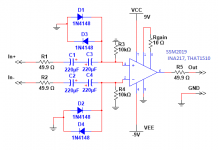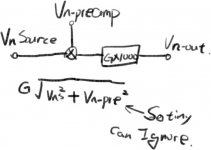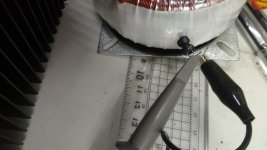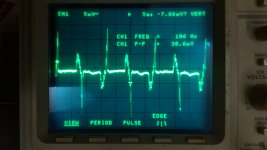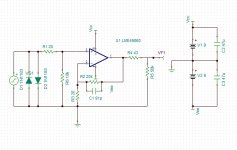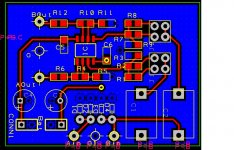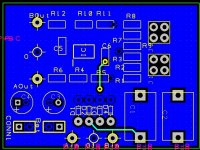Audio amplifier. TL072 and similar.
You measure hiss on the *output* of your preamp. So already the 1uV RTI hiss is 10uV or 50uV. That will not read on a milli-Volt scale. Wire a TL072 stage for gain of 100. Now you are up in the milliVolts. The TL072 self-hiss is ~~2uV so will not add hiss to any high-gain preamp.
I have *never* needed to measure hiss exactly. Either the hiss of my circuit is similar to other good circuits, or at least low-enough, or there is A Problem.
True, I don't hear hiss at all when I short my circuit, and turn the volume to maximum. It only happen when I connect my DAC which is only 108dB SNR, then I can hear pretty loud hiss on a sensitive headphone when volume is maximum. My DAC is kind of interesting, once the music is off, it will have pretty loud noise, but shuts itself off after few secs, then you don't hear a thing.
My actual design noise level will be very low, that's why I would like to measure it or at least know what I'm doing. So far I saw millivolts meter which can measure down to 300uV, I don't know should I buy it or just build it by my own.
If I recall it correct, noise combine itself between stages like square root fashion. I don't know if the crappy amp inside millivolt meter will affect the accuracy when you do zeroing on the analog one.
Ray Dolby wrote a paper, in the form of a JAES pre-print which pointed to the region of 5 to 7kHz as the area to which the human ear was most noise-sensitive.
I think we have a lot more issues with hum of the 50/60 100/120 Hz variety...
You mean like the A-weighted filter for measuring noise?
In what case the AC power will affect the circuit? with my small current design it wasn't a problem at all if I just filter the DC supply. PSRR on both op and LM317 does a wonderful job. But I do hear light buzz when volume is maximum. Does the buzz come from 120Hz variety or it belongs to another department?
Make a simple high gain buffer powered from a pair of 9V battery. Use a low noise op-amp like OPA1652 which has super low current density noise and also decent voltage noise. Put it in a metal enclosure for shielding.
Connect it to a half decent line level sound card input on your PC. The motherboard sound input might be okay but some are really poor. You would need to try it. If you have the money, something like Behrigner UCA202 has an okay line input (range up to 22KHz). I use an EMU0404 which has really clean inputs (range up to 96KHz). Now you can see the noise on FFT. If you want to see above 96KHz you will need a 'scope, maybe PicoScope or Analog Discovery.
Make sure you have DC coupling capacitors to protect your sound interface!
My mother board sound card isn't okay at all. I use it to try how bad on-board sound card is. The noise amplified by my circuit pretty well and so audible. That's not the problem. If I put laptop on top of my circuit with no shielding, it's capable of making it unstable. That's just dark magic in my eyes
With the plug in sound card, do you read the absolute value of noise or just in dB? will be able to see noise FFT sounds wonderful though, easier to know what's impacting your design.
We get ear protectors when shooting clays.
There are lots of designs on the web -- me, I have several -- one uses SSM2019 with gain of 100, and noise in the vicinity of 1nV/RtHz.
Because noise is always referenced with respect to bandwidth, if you are going to compare with others you MUST filter the output of the noise amplifier so that you can compare results with others. You can use a 20Hz to 20kHz bandpass filter, 20kHz to 80Hz etc.
You mean design of low noise amp to hook up before a millivolt meter or voltmeter itself? I'll look it up.
by the way, 1nV/RtHz is very very impressive.
You mean design of low noise amp to hook up before a millivolt meter or voltmeter itself? I'll look it up.
by the way, 1nV/RtHz is very very impressive.
1nV/root Hz is impressive, but the way that happens is to use a low noise preamp with significant gain, 40 or 60dB or thereabouts. When you have a chain of amplifiers, if the first one has significant gain, then the noise contribution of all of the devices further down the chain is minimized. All you need to do is subtract the preamp gain in dB from your noise measurement and you're set.
The tradeoff is that you have restricted your dynamic range, so you're measuring only the noise floor with no signal. That's fine though, and it's the only way to get an accurate noise measurement with noisy downstream measurement devices. Perhaps switchable gain of 40 or 60dB can make sense if it's easy.
As Jack mentioned, there are a handful of possible amplifiers that can be used for this. All-in-one mike amp chips like the SSM2017 or the INA217 are good for this since they'll give you a differential input with common mode rejection, and not just a lot of quiet gain.
The basic circuit is an 'instrumentation amplifier', and if you search for those as well as microphone amplifiers from TI, Analog, Linear and THAT, you'll find a dozen or so chips out there, all of which could be fine. If you can find a chip that has an evaluation board, you can just buy that and save yourself the hassle of making a circuit board for it.
IMHO, using a preamp like this is great, but using it with an FFT box is even better. Having a single noise number is sort of annoying, as all noise is not the same. Viewing it as an FFT can help you to tweezer out hum and other odd spurious tones from pure white noise. as well as see the overall curve of the noise - is it LF? Is there an odd HF peak? All of that is far more interesting than just a single number. I find this helps me to understand what the circuit is doing far better than just a single noise number. The same goes for distortion measurements - THD+N is pretty useless for a quality circuit, since almost all of it will be noise.
For our mutual edification, I found a copy of the CCIR/ARM curve -- compared with A-weighted and DIN4505.
I have the CCIR filter on one of my analyzers -- but you rarely see anyone specifying it.
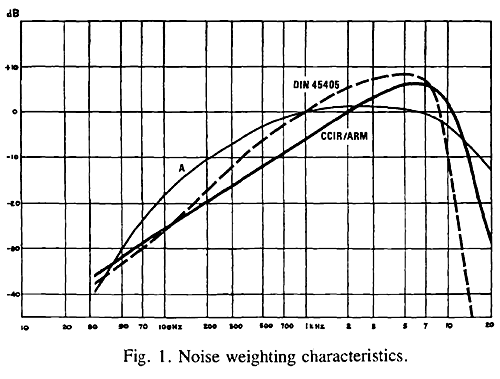
Here's the basic SSM2019 amplifier -- you can use other amplifiers (INA217, THAT1510). THAT1510 might be best and least expensive of the lot ($4.63 at Mouser).
For RF applications, noise is very important and the folks at TI and ADI are crushing prior statistics with new low-dropout, low-noise regulators. If you were working at one of these giants, then you'd need an amplifier with noise less than 600pV/RtHz!
I have the CCIR filter on one of my analyzers -- but you rarely see anyone specifying it.

Here's the basic SSM2019 amplifier -- you can use other amplifiers (INA217, THAT1510). THAT1510 might be best and least expensive of the lot ($4.63 at Mouser).
For RF applications, noise is very important and the folks at TI and ADI are crushing prior statistics with new low-dropout, low-noise regulators. If you were working at one of these giants, then you'd need an amplifier with noise less than 600pV/RtHz!
Attachments
Sounds like your ground arrangment is less than ideal to me. Get the thing on fft and see what is in the noise.
Thank you sir, I found the problem of annoying buzz. I bought a 'Audio Quality' toroidal transformer from China. the setup is very near my output air inductor, which is perpendicular to the transformer. It acts as a pretty good antenna. the magnetic field string thing hit right on the jaw of my inductor. Heavy blow I have to say.
How Do I find out? A tiny inductor on oscilloscope's probe as antenna, probing my fancy transformer. Well, the wave form shows it behaves worse than my cheap industry type transformer.
I told the seller, he ask me to buy some mu metal from him, which will fix it. Jee...
When you have a chain of amplifiers, if the first one has significant gain, then the noise contribution of all of the devices further down the chain is minimized. All you need to do is subtract the preamp gain in dB from your noise measurement and you're set.
If the measurement is 100mv after 60dB preamp, that means actual noise 100uV? I'm used to calculate it by pA, nV/hz. just to make sure. with gain of 40db to 60db, I better put 22khz filter behind gain stage,does it have to be sharp roll off?
I'll get the IC you and jack suggested, i have few opa1612 and opa1632 laying around. but building a instrument amp with opa1612 costs more and failure rate increases.
IMHO, using a preamp like this is great, but using it with an FFT box is even better.The same goes for distortion measurements - THD+N is pretty useless for a quality circuit, since almost all of it will be noise.
FFT box, you mean Fourier transfer function analyzer kind of thing? would my cheap 2i2 sound card help in this case?
Thank you for your advice. Finally I got a sick oscilloscope, tektronix 2432A, can measure down to 2mv, and average can be down to 200uV. Finally get the grandpa to work. Also I got a cheapo external sound card 2i2, hope I will learn how to do some measuring here.
Here's the basic SSM2019 amplifier -- you can use other amplifiers (INA217, THAT1510). THAT1510 might be best and least expensive of the lot ($4.63 at Mouser).
noise is very important and the folks at TI and ADI are crushing prior statistics with new low-dropout, low-noise regulators. If you were working at one of these giants, then you'd need an amplifier with noise less than 600pV/RtHz!
I'll get the INA217 for preamp. TI doesn't offer a ti-tina model for this, makes me nervous. diode for protection, limit the input voltage, 220uf in series forms high pass to filter out DC with 10k resistor, is that correct?
would you suggest attach A-weighted filter behind gain stage or just simple preamp into measurement machine. If connect it directly, what about the nasty DC offset?
Sorry for the silly question combos, just you and other members taught me more than textbook.
And you're absolutely right about noise impact on listening experiences. With my new bought grandpa scope, it shows me the problem with previous built, super light buzzing sound with headphone, it's far more annoying than hiss. Feels like miniature mosquitoes on my right headphone.
My special ordered audio quality transformer from China isn't that top notch as their ads described. 200uh, if I aim it at the right angle, the sensing voltage is actually over the chart. as A newbie, for sure I align my output inductor perfectly so it can receive all the energy from my my noisy audio quality transformer.
Oh, with my scope, I learn 2 very important things.
1. my scope is dog poo, but I love it
2. the environment is very noisy, I didn't realize everything is antenna and noise source is just everywhere
Attachments
I didn't realize everything is antenna and noise source is just everywhere
I designed and built an amplifier.
I put the scope on it and it was oscillating badly.
I tried increasing VAS capacitor to reduce gain.
Nothing worked to fix it.
I then turned off my bench light and the oscillation went !
The fluorescent light has an oscillator inside it and was radiating into my amplifier just below it.
Many years earlier I was trying to fix a modem which had an oscillation in it.
I had put my sig gen on top of the scope and the sig gen was radiating into the scope and putting out 50Hz !
No. All above 16 or 17 kHz is not audible. Just Batman can hear something.Is the noise above 20khz audible ,
or the noise is only audible under Bandwidth?
More BW means more noise. A limited BW is a must. Protects your speakers.
Finally my INA217 arrived, before doing INA217 , I built a tiny test board with lme49860, 60dB gain, just to learn how to build such a thing, very interesting experience I have to say.
My scope isn't top notch,tektronix 2432A so I use average to measure the performance. I short the circuit on the jumper, and short the cap, It reads around 400uV.
Without shields, even short on tiny input cable is too noisy and unstable to measure.
Thank you everyone who guided me how to do such a thing.
My scope isn't top notch,tektronix 2432A so I use average to measure the performance. I short the circuit on the jumper, and short the cap, It reads around 400uV.
Without shields, even short on tiny input cable is too noisy and unstable to measure.
Thank you everyone who guided me how to do such a thing.
Attachments
For what do you need 60dB gain?
I was hoping to be able to measure down to 1uV noise for pre-amp and headphone amp. Don't know much about measurement, maybe I don't need that much gain. Also I'm not that good in doing layout, I was hoping able to measure the differences.
My sound card is 105dB SNR, I just measured it, 0.707Vrms input. and my scope I bought it broken and fixed it to save some money, not very top notch, tektronix 2430A.
For sure I'm not going to do EEG
What would be appropriate gain for my equipment.
You built a Johnson noise amplifier. For headphones 10-16dB gain are enough.
It is, with INA217 I'll follow the suggestion above, make it adjustable will be more reasonable. 60dB is very sensitive. But I learn so much from this tiny project.
Now I have a bit more confidence to build low noise amp.
- Status
- This old topic is closed. If you want to reopen this topic, contact a moderator using the "Report Post" button.
- Home
- Source & Line
- Analog Line Level
- Is noise audible above 20kHz
